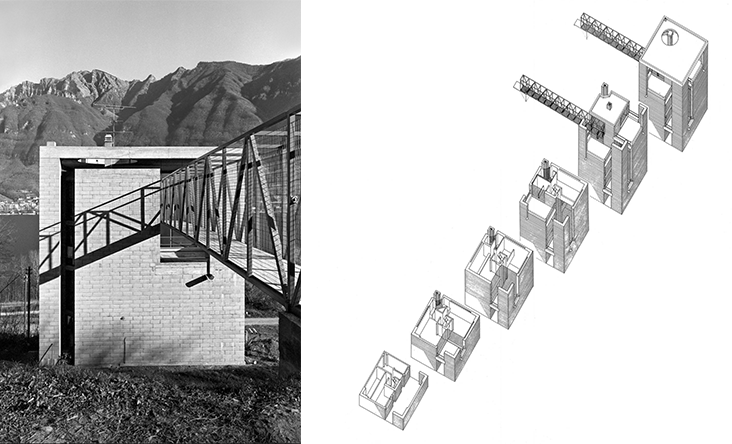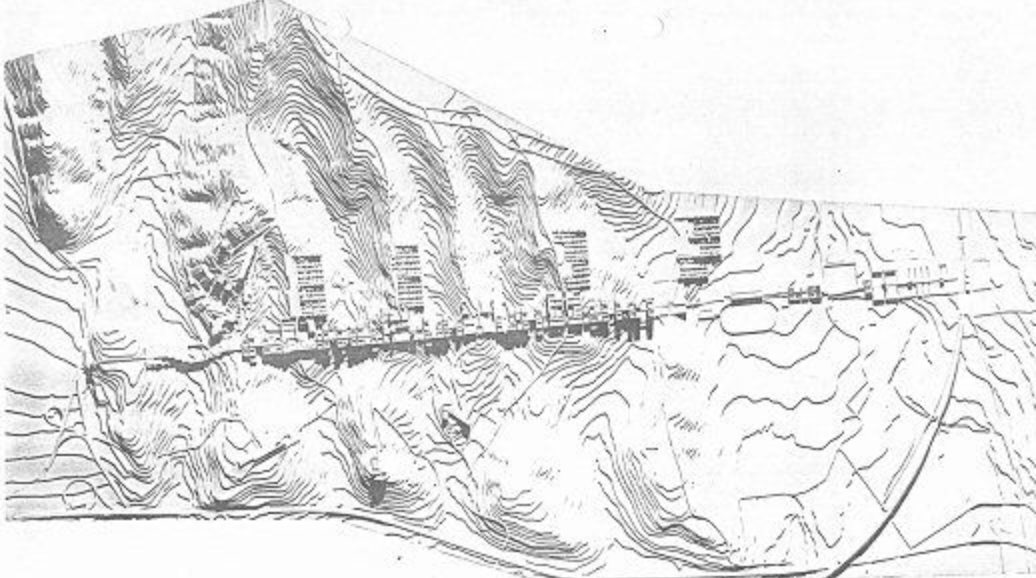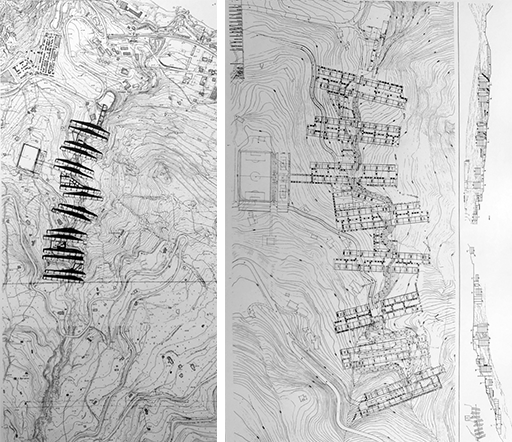
Architecture: principle of settlement. I believe that for architecture to exist within a landscape, it should be site specific. This desire for permanence has always given architecture a raison d’être to belong to a site, a place, or more importantly, a context.
To display and transform the specificities of a particular place is about the transformation of the cultural, historical and social circumstances of its context. But what does this statement mean in a larger intellectual framework, and how should one approach the vocation of the site, or what classical Roman religion defined as the genius loci; a location’s distinctive atmosphere or essence of a place? Perhaps, as a first line of defense, we need to understand the word context.
Context
“It is not the building that determines the architecture, but the event.”… “Every place offers a different sort of challenge, and that’s why I think that in architecture the transformation of a place is of greater importance than the building itself.”
Unknown author
Call it background, milieu or even circumstance, the word context is often associated with a number of important social and cultural endeavors. For example,
- when we talk of the identity of a person or race, we relate the individual’s heritage to a context, to the place of their forefathers that both distinguishes, and, consequently differentiates them from other individuals.
- When discussing food and gastronomy, context signifies being part of an indigenous way of selecting products and preparing meals that reflect a certain region.
- When wine connoisseurs debate about wine, they often mention the French word terroir, meaning territory. This context of a place, often associated with civilizations that inhabited those regions, has extended its meaning to usually describe the natural and physical attributes of a place such as altitude, exposition, soil and composition. These indicators are geographic and very precisely tied to local characteristics defining the famous wine labels; the viticulture’s letters of noblesse have their origins in the 15th century (enacted as a law in 1905) called Appellation d’Origine Contrôlée (AOC). Image 1, below)
 Image 1: Google images regarding the notion of terroir
Image 1: Google images regarding the notion of terroir
The combination of the physical ecosystem of a place, associated with traditional human gestures of inventing and re-inventing man-made landscapes, connect the word context to time and place. This fundamental understanding is no different than when an architect talks of the context of a site. Attributes of context are markers that engage an architectural project in a deliberate manner; either by espousing the site by interpreting relationships between the context and the project, or at times denying complicity with the larger environment, offering stark contrast between the context and the building, be it at the urban, suburban, or rural scale (Image 2, below).

Reading a site
“There is a terror connected to architecture: construction always means depletion of materials, displacement of matter in general, and erasing something pre-existent. It also means cutting the group;nd, and often anchoring things semi-permanently in the skin of the earth. The cut as wound remains a memory in history, but the cut can also be seen as something beneficial that erases a wound, or excises a conflict or a trauma”.
Raoul Bunschoten, Architect
Italian architect Vittorio Gregotti calls these positions a principal of settlement and suggests that any project begin with a careful reading of the given context to anchor any future project. If the metaphor of reading is appropriate, in particular prior to intervening physically on a site, this suggests that the site is like a text that one may read to uncover meaning through a series of codes and signs.
Then, would the metaphor of creating words and meaning through the arrangement of letters, syntax and grammatically correct rules be equally appropriate in reading a site? If yes, this begs the question: does architecture have the same capacity as literature to engage the site as a text in order to “read” and “write” about it?
Site as palimpsest
“Every building violates the earth. Every architect therefore has the responsibility to ensure that this charged guilt of violating the given earth can only be reconciled through cultural and artistic improvement.”
Dieter Steiner on the work of Raimund Abraham
I believe it does, but with the caveat that there is no single reading of a site, as even an informed understanding of a place can’t completely reflect centuries of natural and man-made interventions. The superimpositions and layering of multiple influences lead the architect to approximate the identity of a site. Like a palimpsest, sites are constructed and deconstructed (written and erased) over time and meanings emerge in support of the architectural project. The suggestion that “the acceptance of reality begins with knowledge of place…”[1] is a way to proceed to “reveal” what one understands the site to be and not to impose preconceived ideas.
And yet, when dealing with a site, architecture’s strength is both about inheritance and projecting meaning upon a site, redefining it to enable architecture to partake in creating something new, appropriate and meaningful. As much as the building takes from the site, as much that it needs to impact positively on its surroundings, it must enhance the site so that the existing (the context) and the new (project) are more than the sum of both parts.
 Image 2: Google images -Mario Botta design for the Casa Bianchi
Image 2: Google images -Mario Botta design for the Casa Bianchi
Casa Bianchi by Mario Botta
“Architecture is the constant fight between man and nature, the fight to overwhelm nature, to possess it. The first act of architecture is to put a stone on the ground. That act transforms a condition of nature into a condition of culture; it’s a hole act.”
Mario Botta, architect
As an architectural student I visited the Casa Bianchi (1971-73), designed by now famed Swiss architect Mario Botta (1943-), located north of the historic town center of Riva San Vitale. Botta’s early genius — he built this house upon graduation from school — was to move from a localized site strategy (where the building anchors itself to the ground and immediate environment) to a territorial scale of siting his architecture. There is much to be noted about this house:
- how the architect interprets existing vernacular and regional traditions,
- the compact building shapes with simple platonic volumes;
- and the facades that respond to the surrounding environment.
Yet, what interests me here is the architect’s ambition of anchoring the building into its context. The desire to build a place come to define the Ticinese Tendenza, an architectural movement that saw the ability of architecture to build the landscape rather than “the original and symbolic act of making contact with the soil”[2]; in other words, a territorial understanding of the meaning of context.
 Image 3: Sequence from entrance framing the view on the other side of the lake (Author’s collection)
Image 3: Sequence from entrance framing the view on the other side of the lake (Author’s collection)
Principle of settlement, historically and geographically
The landscape as such only exists in the eye that looks at it.
Karl Wilhelm Friedrich Schlegel, German poet and literary critic
In this example, at the foot of Monte San Giorgio, Botta creates a vertical home (metaphor of the historic “Roccoli” towers from which one hunted birds) whose main access is through an elevated metal structural passerrelle. As one enters the walkway, the site slopes rapidly under the feet to reveal a framed view of the historic church of Sant’ Andrea situated on the other side of Lake Lugano, in the small village of Melano.
Here, the entrance procession frames the landscape and creates an observatory overlooking the lake and immediate surroundings. Siting is about the immediacy of anchoring the building, but here the context becomes emblematic in the way Casa Bianchi measures the site historically and geographically. An exquisite and timeless demonstration of a principle of settlement; the new architectural object and context are in unison, in fact the architecture is now context to be read and interpreted. Image 4: Sketch showing principle of settlement (Author’s drawing)
Image 4: Sketch showing principle of settlement (Author’s drawing)
 Image 5: Google image -Project for the Calabria University, by Vittorio Gregotti Associates
Image 5: Google image -Project for the Calabria University, by Vittorio Gregotti Associates
 Image 6: Lotus International No. 15, 1977 -Site strategy for a choosing complex in Cefalu, Sicily, Italy, by Italian architect Vittorio Gregotti
Image 6: Lotus International No. 15, 1977 -Site strategy for a choosing complex in Cefalu, Sicily, Italy, by Italian architect Vittorio Gregotti
 Image 7: Lotus International No. 15, 1977 -Site strategy for a Sports Centre in Bellinzona, Ticino, Switzerland by Ticinese architect Aurelio Galfetti
Image 7: Lotus International No. 15, 1977 -Site strategy for a Sports Centre in Bellinzona, Ticino, Switzerland by Ticinese architect Aurelio Galfetti
[1] Moneo, Rafael. Alvaro Siza in Theoretical Anxiety and design strategies: in the work of eight contemporary architects. Cambridge: MIT Press. 2004.
[2] Guacci, Gian P. Settlement or methods and forms of a modern issue (academia.edu)
Additional blogs of interest regarding this theme
Lessons from vernacular architecture -Casa Rezzonico by Livio Vacchini, Switzerland
Architectural Education: Herzog et de Meuron’s Tavole House
Architectural Education: La Petite Maison by Le Corbusier